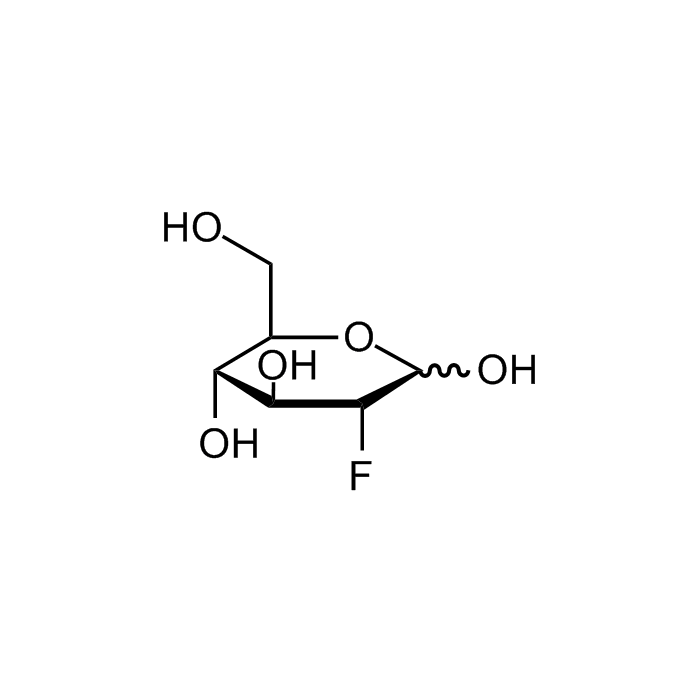Cookie Policy: This site uses cookies to improve your experience. You can find out more about our use of cookies in our Privacy Policy. By continuing to browse this site you agree to our use of cookies.
Chemodex
2-Fluoro-2-deoxy-D-glucose

| Product Details | |
|---|---|
| Synonyms | 2-Deoxy-2-fluoro-D-glucose; FDG; 2-FG; Fluorodeoxyglucose |
| Product Type | Chemical |
| Properties | |
| Formula |
C6H11FO5 |
| MW | 182.15 |
| CAS | 29702-43-0 |
| Purity Chemicals | ≥97% (NMR) |
| Appearance | White to yellow powder. |
| Solubility | Soluble in DMF (30mg/ml), DMSO (30mg/ml) or water (10mg/ml). |
| Identity | Determined by 1H-NMR. |
| Declaration | Manufactured by Chemodex. |
| Other Product Data |
Click here for Original Manufacturer Product Datasheet |
| InChi Key | ZCXUVYAZINUVJD-IVMDWMLBSA-N |
| Smiles | O[C@H]1C(F)C(O)[C@H](O)[C@@H](CO)O1 |
| Shipping and Handling | |
| Shipping | AMBIENT |
| Short Term Storage | +4°C |
| Long Term Storage | -20°C |
| Handling Advice | Protect from light and moisture. |
| Use/Stability | Stable for at least 2 years after receipt when stored at -20°C. |
| Documents | |
| Product Specification Sheet | |
| Datasheet |
 Download PDF Download PDF |
2-Fluoro-2-deoxy-D-glucose [FDG] is a glucose analog that inhibits cellular glycosylation. It is the natural isotope-form of 18F-FDG that can be taken up by cells but does not undergo metabolic glycolysis. FDG uptake is closely related to the expression of the glucose transporter (GLUT) in malignant tumours. FDG is also a substrate of hexokinase isozymes and an inhibitor of cellular glycosylation. FDG is taken up by high-glucose-using cells such as brain, brown adipocytes, kidney and cancer cells, where phosphorylation prevents the glucose from being released again from the cell, once it has been absorbed. The 2-hydroxyl group (–OH) in normal glucose is needed for further glycolysis (metabolism of glucose by splitting it), but FDG is missing this 2-hydroxyl and cannot be further metabolized in cells. FDG is used in positron emission tomography (PET) as contrast agent and is the most widely used PET marker. FDG-PET can be used for diagnosis, staging, and monitoring treatment of cancers, particularly in Hodgkin's disease, non-Hodgkin lymphoma, colorectal cancer, breast cancer, melanoma, and lung cancer. FDG has also anticancer and chemosensitizing activity.
(1) H. Minn, et al.; Res. Exp. Med. 191, 27 (1991) | (2) Y. Kanazawa, et al.; J. Neurochem. 66, 2113 (1996) | (3) T.J. Lampidis, et al.; Cancer Chemother. Pharmacol. 58, 725 (2006) | (4) Y. Liu, et al.; Prostate Cancer Prostatic Dis. 9, 230 (2006) | (5) Y. Pina, et al.; Invest. Ophthalmol. Vis. Sci. 53, 996 (2012) | (6) A. Fantagare & A. Svatos; Front. Plant Sci. 7, 483 (2016) | (7) S. Niccoli, et al.; PLosOne 12, e0187584 (2017) | (8) N. Hasnain, et al.; J. Pak. Med. Assoc. 70, 2291 (2020)





